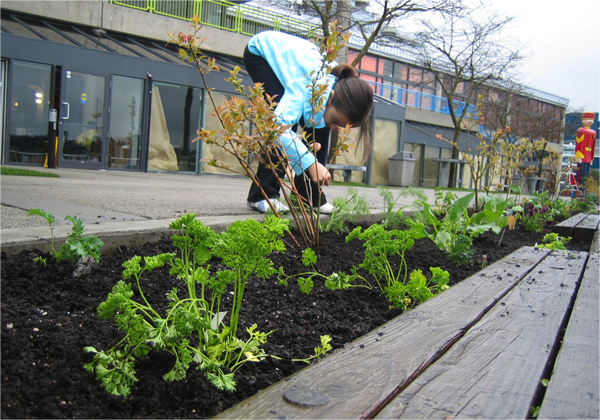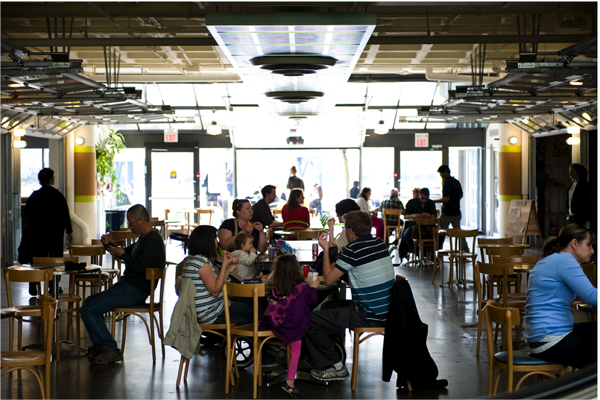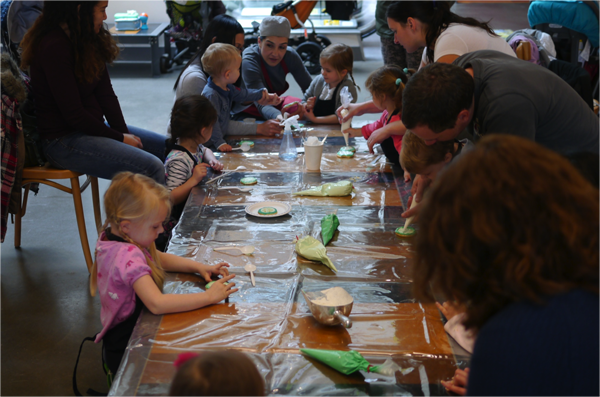After undertaking River Market's revitalization, Tomo Spaces managed its operation. In 2021, River Market transitioned to a new ownership and management group. This short reflection is a look back at some design intentions and lessons learned.

As a public market, food naturally was given a central role. The public market’s revitalization centred around the transforming roles food has in both social and design terms. We asked: How does a public market remain relevant in community life? Furthermore, if there are models for arts-led revitalization, what is the model for food-led revitalization?
In 1985, Westminster Quay Public Market opened as a 72,000 square-foot retail destination along the Fraser River, accompanying Skytrain construction and condominium development on New Westminster’s waterfront. Over the years, it declined steadily like many public markets in North America. They have been most successful in cities with large number of tourists and office workers. In locations lacking these supports, they have struggled. Many closed or re-tenanted to national franchises. Their once novel setting increasingly lost its appeal. Shopping malls and grocery stores soon co-opted the public market’s look and feel. By the time the Westminster Quay Public Market was closed for redevelopment in 2008, two-thirds of the stalls were vacant.
We worked with the premise that public markets need to become a place for activities, beyond commerce. A “market” is where one buys and sells things. But commerce by itself does not distinguish a public market from a shopping mall. For us, “public” means cultural and convivial activities; and in our project these activities centred around food.
We applied the “activity precinct” framework developed by design consultants HB Lanarc and Dialog to establish a food precinct.1 As a planning concept, a precinct is a place developed around activities. We identified six key food activities – growing, processing, selling, serving, eating, and composting – that would guide design and tenant mix. We dubbed this approach Food 360. The first floor was designed as the Hungry Floor with a food hall showcasing the region’s best independent eateries. The second floor was imagined as the Curious Floor, feeding creativity with facilities like The Vancouver Circus School.
Central to good urban design is the capacity to foster a sense of place in ordinary places.2 And so while the Market is a place for consumption, it should also aim to be a place for social interaction and encounters in which food has a key role. The spatial design and programming supported this aim. For example, the landscaping around the market was transformed into an edible community garden. The central food hall, designed to function as a seating area, served as a gathering space. It has been used for a community lecture series, birthday parties, fundraisers, and wedding receptions.

Another design consideration was the layout of vendor spaces. Taking a different approach from traditional markets where vendors are allocated small stalls, River Market’s redesign provided shops storefront-like spaces outfitted with commercial kitchens. Consequently, the Market could accommodate fewer shops than its 1986 design. Some visitors expressed disappointment, expecting a market of small stalls similar to bazaars or farmers’ markets. However, importantly, this design provided shop owners with the opportunity to expand their business beyond food retailing at the market, such as preparing food for catering or hosting pop-up dinners in their market kitchen.
A unique aspect of River Market has been its tenant mix of locally owned businesses. River Market’s goals have brought together like-minded entrepreneurs who contribute greatly to realizing the activity precinct around food. The owner of the bakery has taught a weekly baking class for children and the chefs at two of the restaurants have held regular cooking demonstrations as part of the dining experience. We held food competitions in which market chefs and staff volunteers competed in cookoffs. These competitions raised money for local organizations, invited market visitors to taste and vote for their favourite, and fostered a sense of community among all of us who worked at the Market.

Food has also been a connector, strengthening the link between residents and local businesses. For example, one of the challenges we faced with starting a market around local restaurateurs was the lack of bank financing. To overcome this challenge, we tested a crowd-sourced financing model. Two of the market’s restaurants had such founders programs through which residents invested and helped with start-up capital. In return, the founders receive food and beverage credits.
To strengthen the connection between buying local and local prosperity, we launched a customer loyalty program called ONE New West in partnership with our anchor grocer, Donald’s Market. Unlike other customer appreciation programs that focus primarily on points collection, Donald’s Market placed members' 1% savings off grocery bills and contributed another 1% into a fund to kick-start local projects. Every year, we facilitated a grassroots ideas competition where residents and community organizations submitted project proposals and ONE members voted on which projects receive funding. This initiative funded projects such as a shuttle program that took seniors to farmers’ markets and Popluck that convened open-air potluck dinners in public spaces around the city.
Placemaking is about strengthening the connection between people and the everyday places they share. It concerns the process of creating places that people care about and want to be in. Some practical lessons we learned include:
- A commitment to a clear project vision was critical. The old public market, despite its ups and downs, was remembered with nostalgia. A clear vision helped us communicate to the public why we were making changes.
- Social activities and programming are just as important as the physical infrastructure. Social activities that create opportunities for encounters need to be cultivated and attention need to be paid to creating and sustaining them before they take on a life of their own.
- Independent businesses are vital to a vibrant local economy and place. Working with market shop owners, I saw the work and sacrifices that went into each business. They require more support – more financial and technical assistance. The intent is not only to lease to local businesses but also to support their growth.
Independent businesses are vital to a vibrant local economy and place. —Leslie
References
1 HB Lanarc Consultants (2008). The power of precincts: Overview of core concepts. Document prepared for River Market Westminster Quay.
2 Knox, Paul, L. (2005). Creating Ordinary Places: Slow Cities in a Fast World. Journal of Urban Design, vol. 10(1), 1 – 11.
